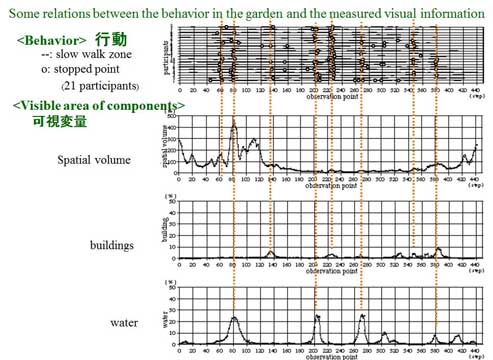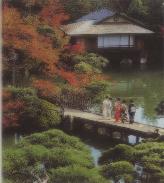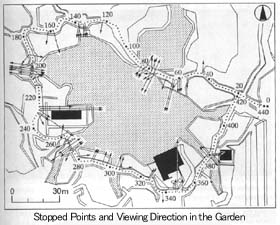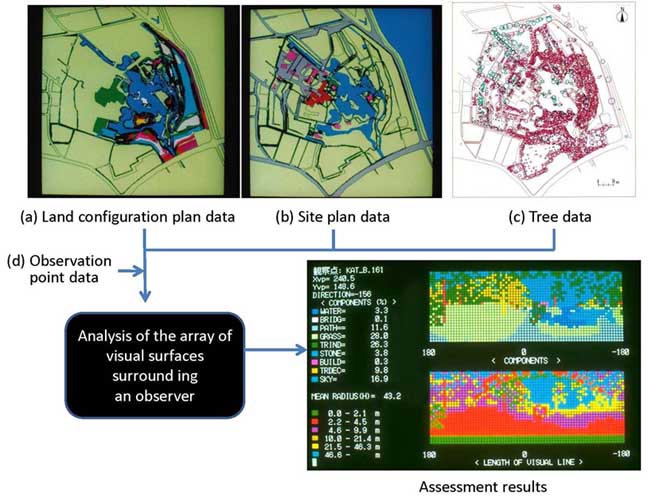|
Research Subjects>Places> Gardens
|
 Effect of landscape design on depth perception in classical Chinese gardens: A quantitative analysis using virtual reality simulation
Effect of landscape design on depth perception in classical Chinese gardens: A quantitative analysis using virtual reality simulation
|
|
<Frontiers in Psychology, Nov. 2022>
Haipeng Zhu, Zongchao Gu, Ryuzo Ohno and Yuhang Kong
|
| It is common for visitors to have rich and varied experiences in the limited space of a classical Chinese garden. This leads to the sense that the garden’s
scale is much larger than it really is. A main reason for this perceptual bias is the gardener’s manipulation of visual information. Most studies have discussed
this phenomenon in terms of qualitative description with fragmented perspectives taken from static points, without considering ambient visual
information or continuously changing observation points. A general question arises, then, on why depth perception can vary from one observation point
to another along a garden path. To better understand the spatial experience in classical Chinese gardens, this study focused on variations in perceived
depth among different observation points and aimed to identify influential visual information through psychophysical experimentation. As stimuli for the
experiment, panoramic photos of Liu garden were taken from three positions at Lvyin Pavilion. Considering the effects of pictorial visual cues on depth
perception, the photos were processed to create 18 kinds of stimuli (six image treatments * three positions). Two tasks were presented to the participants. In
Task 1, 71 participants were asked to rate the depth value of the garden using the magnitude estimation method in a cave automatic virtual environment
(CAVE). Statistical analysis of Task 1 revealed that depth values differed significantly among different viewpoints. In Task 2, participants were asked to
compare 18 stimuli and 3D images presented on three connected monitors and to judge the depth of the garden using the adjustment method. The
results of Task 2 again showed that depth values differed significantly among different viewpoints. In both tasks, ambient information (i.e., the perspective of
interior space) significantly influenced depth perception. |
|
| Paper → PDF file
|
|
|
 Experiencing Japanese Gardens: Sensory Information and
Behavior
Experiencing Japanese Gardens: Sensory Information and
Behavior
|
|
<Handbook of Japan-United States Environment-Behavior Research: Toward
a Transactional Approach, Wapner, S. et al Eds., Plenum Press, New York
and London, Chap.12, Pp.163-182, 1997>
Ryuzo OHNO, Tomohiro HATA, Miki Kondo
|
OBJECTIVE:To examine the hypotheses that behavior changes at certain places in a
Japanese garden, and the sensory information at those points are
responsible for these changes.
In
a circuit-style Japanese garden at Kobe, 21 subjects were asked to move
around freely along the circuit path one by one. Each subject's movement, viewing direction and walking pace were
recorded at every 50 centimeter (one pedestrian step). In order to
analyze each subject's behavior the sensory input at a particular
visual field was measured by a computer program. This measurement was
taken at every step. By analyzing the measurements it was found that :
-one's
viewing direction was first used to acquire enough information for a
safe movement.
-then ambient information chose the frame of visual field
and
-if
one detects something within the visual field focal vision operates to
pick up detailed information from it.
|
 |
| Full Paper → PDF (Book chapter) |
  |
|
 Measurement of the Multi-Sensory Information for Describing Sequential Experience in the Environment: Measurement of the Multi-Sensory Information for Describing Sequential Experience in the Environment:
An Application to the Japanese Circuit-Style Garden
<The Urban Experience: Proceedings of the 13th Conference of the International
Association for People-Environment Studies, E & FN SPON, pp. 425-437,
1994>
Ryuzo Ohno, Miki Kondo |
|
OBJECTIVE: to reveal the hidden order or rhythm of spatial arrangements
in Japanese garden by measuring multi-sensory information from the environment
with the help of a computer.
Computer programs were developed and applied to the
environmental data of three famous circuit-style gardens in order to
measure the following three aspects of sensory information: (1) ambient
visual information; (2) focal visual information; and (3) non-visual
information such as tactile and kinesthetic information. The profile of
each aspect was obtained by assessing the measurements taken at every
50cm (one step of a pedestrian) along the garden path. Thus,
changes in the profiles of sensory information were identified to
examine the sequential experience as people moved through the garden.
|
 |
| Full Paper → PDF |
TOPへ
|